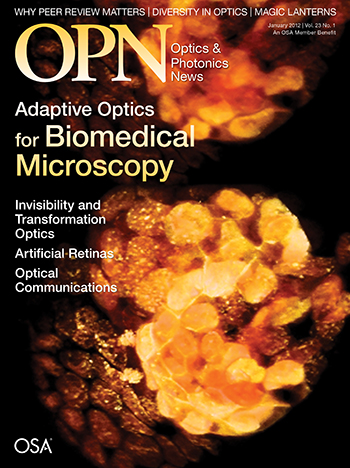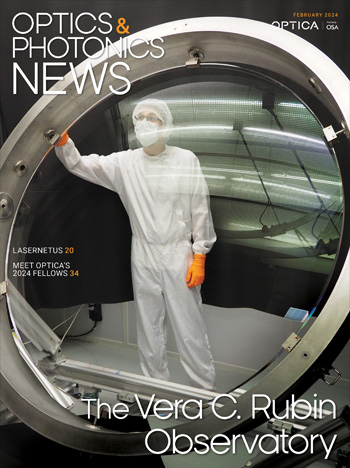
January 2012 Issue
Feature Articles
Adaptive Optics for Biomedical Microscopy
Over the last decade, researchers have applied adaptive optics—a technology that was originally conceived for telescopes—to high-resolution microscopy in order to overcome the problems caused by specimen-induced aberrations.
by Martin J. Booth, Delphine Débarre and Alexander JesacherFishy Photons: Invisibility and Transformation Optics
As we see when looking at fish in an aquarium, optical materials can distort the actual locations of objects. Scientists are now able to manipulate light in “fishy” ways that may enable big scientific breakthroughs such as invisibility cloaking in the near future.
by Ulf LeonhardtThe Evolution of Artificial Retinas
A new technology that combines optics and neurobiology is slowly illuminating a dark world for some people with blindness caused by retinal damage.
by Mike MayOptical Communications in 2012
Progress in optical communications is being driven by an explosion of new applications and services. This article describes the current state of the field as seen by the organizers of the upcoming OFC/NFOEC conference.
by OFC/NFOEC OrganizersDepartments and Columns
The Magic Lantern of Omar Khayyám
Optical projection techniques are mentioned in several translations of a quatrain from the poem “The Rubáiyát of Omar Khayyám.” What is the true meaning of Khayyám’s metaphor of reality as a shadow show?
On the Power of Small Initiatives
When it comes to effecting big change, sometimes you need to think small.
Feather Nanostructures Inspire Two Laser Designs
Researchers at Yale University, U.S.A., created two lasers by copying the structure in feathers that gives bluebirds (among other animals) such brilliant color.
Presidential Profile: Arthur Francis Turner
Arthur Francis Turner was OSA’s 1968 President and a pioneer in the field of optical interference coatings. He earned many accolades for his work, including a Scientific and Engineering Award from the Academy of Motion Picture Arts and Sciences.
Why Peer Review Matters
The peer review of manuscripts submitted to OSA journals is a hugely important component of the scholarly communication process. In order for OSA publications to remain sustainable, everyone who submits a manuscript should complete at least two reviews. Are you doing your part?
Imaging on a Cellphone? There’s an App for That
A group of California scientists has developed small, inexpensive attachments that allow high-definition cellphone cameras to perform microscopy and spectroscopy in the visible region.
Multi-Mode Imaging Probe Could Detect Ovarian Cancer
Researchers have developed a multi-mode imaging probe that could examine ovarian tissue via minimally invasive surgery.
Trap and Spin Nanoparticles
Researchers recently described a method that allows them to capture particles as small as 110 nm and rotate them around the surface of tiny gold pillars.
Light Generation Nanodevice
Researchers at Stanford University (U.S.A.) have shown electrically tunable harmonic generation of light from a tiny plasmonic cavity.
ADVERTISEMENT
ADVERTISEMENT
Also in this Issue
Book Reviews
In Memory
Remembering OSA Fellow Emeritus William “Bill” P. Barnes Jr. and OSA Fellow Un-Chul Paek.

![A multiplexed image of a human tonsil acquired. [NIAID] using the iterative bleaching extends multiplexity (IBEX) method.](https://opnmedia.blob.core.windows.net/$web/opn/media/images/articles/2024/0424/departments/202404-cover-web.jpg?ext=.jpg)

